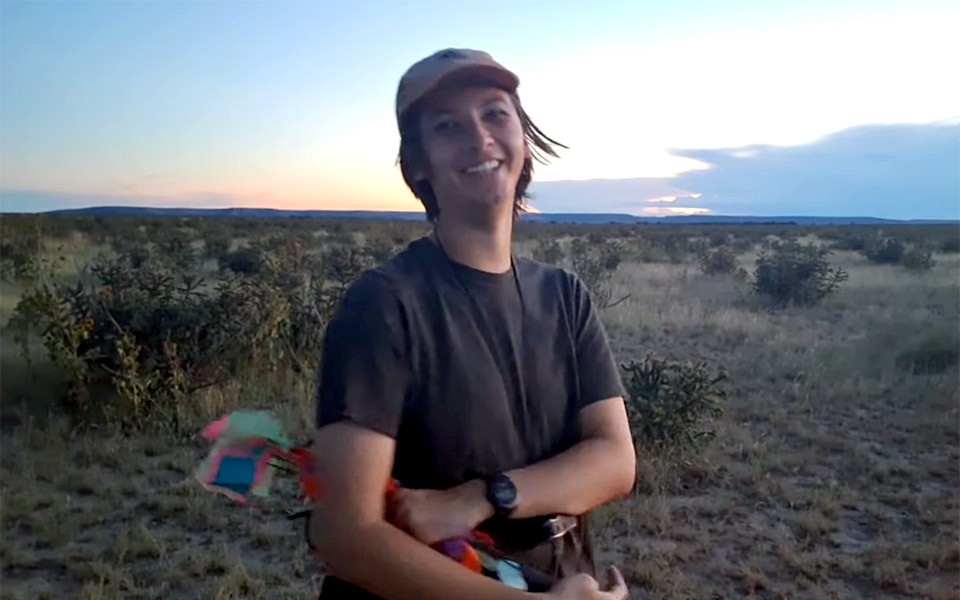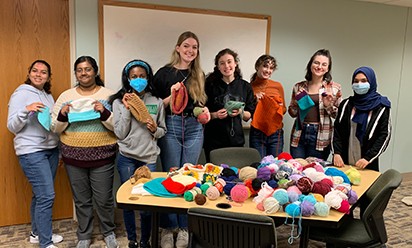EMU graduate student mines valuable tarantula data in the Colorado desert

YPSILANTI— Eastern Michigan University student Bradley Allendorfer spent his second summer in the Colorado desert in 2023, conducting what may prove to be foundational research on tarantulas in the wild.
Allendorfer, a second-year graduate student in ecology, is investigating the behavior of maternal females and their offspring, from the spiderlings’ egg-sac stage until they leave their first home – the narrow burrow that makes them difficult to observe. Allendorfer conducted his research using an endoscopic camera lowered into the ground, capturing what is believed to be the first photo of Colorado Brown Tarantula spiderlings in the burrow. Although several yards of cable connects the camera to the hand-held monitor, Allendorfer said he rarely needed that much, noting the tarantula mothers were quick to put themselves between the camera and their egg sacs to keep the spiderlings safe.
Of the 153 burrows Allendorfer marked for study in the Comanche National Grassland, 19 had egg sacs. Cameras placed outside the burrows took a picture every minute, allowing Allendorfer to compare how often the maternal females emerge, versus those not tending egg sacs.
“I haven’t done a lot of analysis yet,” Allendorfer said, “but I very rarely see the moms with babies come out.”

It’s believed females produce an egg sac every other year. The spiderlings stay with mom after hatching, and emerge from the burrow shortly before the next mating season. Allendorfer doesn’t know how many spiderlings the sacs typically contain, but he’s going to find out thanks to the fact that spiderlings molt: once in the egg sac and again before they strike out on their own.
“I've collected some egg sacks that have the molts of all the babies in them, so I'll go back and count to see how many they really have,” he said.
Cara Shillington, Ph. D., professor of ecology and Allendorfer’s research adviser, says the data he’s collecting will be of significant value to the science community. His project is based on a study she conducted on a Mexican tarantula species, which was published in 2006.
“Bradley’s work is the first time this maternal behavior has been documented with a U.S. species,” she said. “We’re definitely planning on publishing.”
Dallas Haselhuhn, another of Shillington’s students, worked at the same site a year ago, tracking males during the mating season.
“Some of his work is included in the video “True Facts: Tarantulas,” and both of us are mentioned in the credits,” Shillington said, noting Allendorfer started the Colorado project as an undergrad, and received funding from multiple sources for his two summers of research.
“It is a big commitment, spending a chunk of his summer at a field site where he works long hours and often on his own,” she said. “I am so proud of all the work he and Dallas have done.”
About Eastern Michigan University
Founded in 1849, Eastern is the second oldest public university in Michigan. It currently serves more than 14,000 students pursuing undergraduate, graduate, specialist, doctoral and certificate degrees in the arts, sciences and professions. In all, more than 300 majors, minors and concentrations are delivered through the University's Colleges of Arts and Sciences; Business; Education; Engineering and Technology; Health and Human Services; and its graduate school. National publications regularly recognize EMU for its excellence, diversity, and commitment to applied education. Visit the University’s rankings and points of pride websites to learn more. For more information about Eastern Michigan University, visit the University's website. To stay up to date on University news, activities and announcements, visit EMU Today.
September 13, 2023
Written by:
Amy Campbell
Media Contact:
Melissa Thrasher
mthrashe@emich.edu
734-487-4401
More Stories

EMU Honors Crochet and Knitting Club ties the community together through acts of service.

Southeast Michigan Stewardship Coalition at Eastern Michigan University appoints new leadership.




